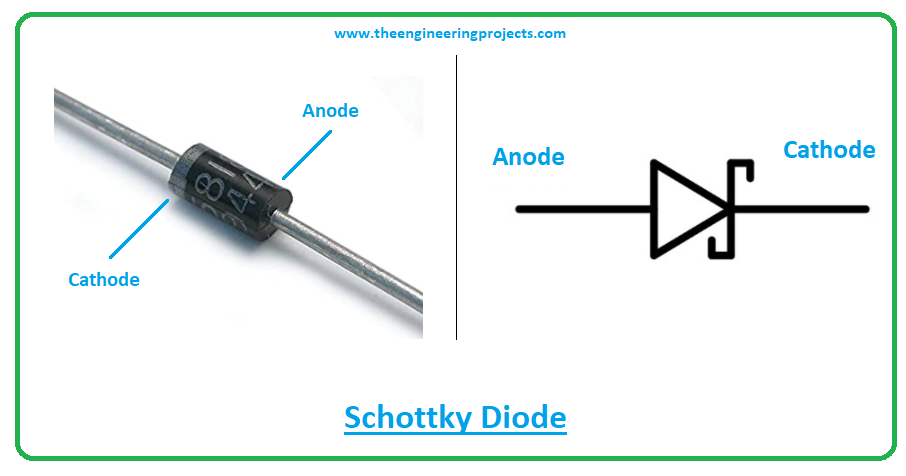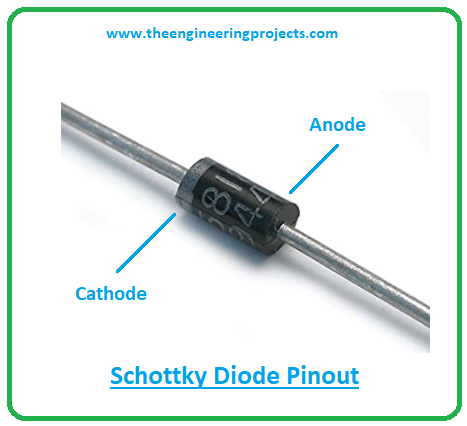
Introduction to 1N5820
- 1n5820 is a Schottky diode composed of semiconductor material and is employed in fast-clamp diode switching applications.
- Schottky diode is also called hot-carrier diode since in an unbiased condition electrons possess low energy on the semiconductor material.
- This low energy leads to the formation of a barrier that blocks the electrons. Due to the formation of this barrier, Schottky diodes are also called hot-carrier diodes.

- Both Schottky diode and normal diode are different in terms of voltage required to power up these diodes.
- The Schottky diode requires only 0.3V out of 2V DC source voltage, leaving 1.7V to power the diode. On the other hand, a normal diode requires only 0.7V, leaving behind 1.3V to power the diode.
1N5820 Datasheet
Before you use this device in your project, it’s always wise to have a look at the datasheet of the device that highlights the main characteristics of the component. Click the link below and download the datasheet of 1n5820.1N5820 Features
- Highly efficient with small conduction losses.
- Protection against overvoltage.
- Carries low forward drop voltage.
- Capable of extremely fast switching.
- Carries high surge capability.
- Comes in package DO-201AD.
1n5820 Schottky Diode Construction
- The 1n5820 Schottky diode is formed when metal is combined with the semiconductor material that results in the formation of a barrier.
- When the n-type semiconductor is combined with metals like platinum, chromium, tungsten, and molybdenum, they make Schottky diode.
- Both p-type and n-type semiconductor material can be used to construct the Schottky diode, but n-type semiconductors are preferred over p-type semiconductor material because later exhibit low forward drop voltage.
- The Schottky diode comes with two terminals where one is an anode and the other is called a cathode terminal. The anode, made-up of metal, is always the positive side of the diode through which current enters the diode. And the cathode side, made-up of silicon material, is always the negative side through which current leaves the diode.
- The conduction is carried out between these two terminals and current flows from the anode terminal to the cathode terminal.
- The nature of semiconductor material and the metal used plays a key role in defining the forward drop voltage of the diode. Low forward drop voltage means less energy is released as heat that makes these diodes suitable for the applications where high efficiency is required.
- These diodes are widely used in the solar systems that prevent the batteries from discharging in the absence of solar heat.
1N5820 Pinout
The following figure represents the pinout image of 1n5820.
- 1n5820 is composed of two terminals mainly used for the external connection with the circuit.
- These terminals are called the anode side from where the current enters the diode and the cathode side from where the current leaves the diode.
- The anode side is positive, made up of metal and the cathode side is negative, made-up of silicon material. The current flows from the anode terminal to the cathode terminal.
1N5820 Applications
- Employed in high-frequency and low voltage inverters.
- Used in sample-and-hold circuits.
- Can control the electronic charge.
- Used in DC/DC converters and polarity protection applications.
- Incorporated in freewheeling and logic circuits.
- Used for signal detection and radio frequency applications.
- Employed in extremely fast switching applications.
- Used in stand-alone photovoltaic systems.



 Electronic Components
Electronic Components jameswilson
jameswilson 0 Comments
0 Comments


















 2.3k
2.3k
 953
953
 921
921
 2.1K
2.1K

